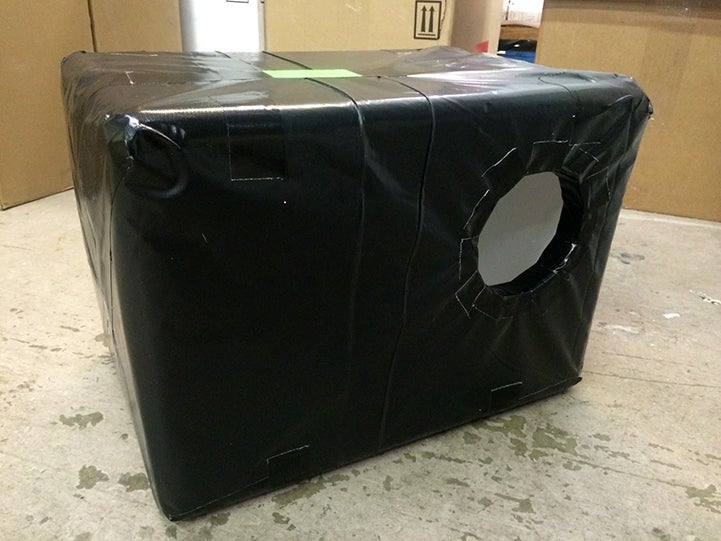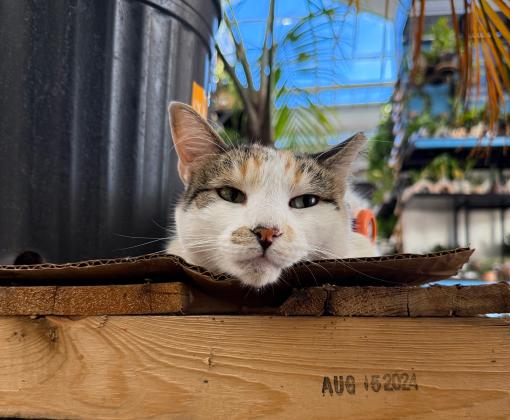
How to Help Outdoor Cats in Winter
If you've noticed community cats (i.e., ownerless cats who live outdoors) in your neighborhood, you might be wondering how you can help these outdoor cats in the winter. The cats will grow a thicker coat of fur when it gets cold outside, but they still need protection from the harsh weather.
Here's a comprehensive guide for how to build an outdoor cat shelter, as well as tips on what to feed community cats during winter months and how to make sure they stay healthy and safe.
How to build an outdoor cat shelter
There are many kinds of DIY outdoor cat shelters. The more elaborate ones might require power tools and a little construction know-how, while other homemade houses, such as the one shown below, are very simple to make with inexpensive materials that are easy to find.


See how your community is doing
This outdoor cat shelter was designed by David and Susan Trussell, longtime volunteers for Best Friends Animal Society, who have built countless Styrofoam shelters for community cats. To find out how they do it, watch the video below of the Trussells making a cat shelter.
Cat shelter materials
Here are the materials and tools you’ll need to make this outdoor cat house:
- Styrofoam cooler: Many people ask their veterinarian to save the large Styrofoam coolers they get their vaccines shipped in because they are extra thick and are perfect for cat shelters. Hospitals, fish markets, and even grocery stores also might be glad to donate large coolers.
- Roll of thick black plastic: You can purchase rolls of black plastic at any home improvement or garden store. Don’t use garbage bags because they’re too thin and will tear.
- Gorilla Tape (or other industrial-strength, waterproof tape): You’ll use this tape to secure the black plastic to the cooler and cover any exposed areas near the door hole. One roll (35 yards) is enough for three shelters.
- Heavy-duty Liquid Nails construction adhesive: You'll use this to seal the lid of the cooler.
- Bubble wrap or other type of insulation (optional): If the cooler is less than 1.5 inches thick, you can cover it with layers of bubble wrap or insulation. When using insulation, be certain that it is the kind that has paper on both sides, and make sure no fibers are exposed when your shelter is completed. (You can tape over any exposed areas near the door hole.)
- A box cutter or a sharp knife: You’ll need a sharp implement to cut a hole in the cooler for the shelter’s door.
Steps to build the outdoor cat house
- Turn the Styrofoam cooler on its side and cut a circular entrance with a 6-inch diameter. Position the entrance hole 1-2 inches below the line where the lid meets the cooler body, and place it at one end of the longer side of the cooler. Two entrance holes are recommended if the shelter will be in an area where predators might pose a threat to the cats.
- Seal the lid with Liquid Nails adhesive.
- Wrap the shelter like you would a present with the black plastic, and tape all the seams securely with your tape.
- After wrapping, locate the door hole and make cuts in the plastic like you’re slicing a pie. Then, tape all around the entrance.
Tips to maximize your winter cat shelter
- To provide extra insulation for the cats, you can make a curtain for the door hole out of two layers of bubble wrap or excess plastic wrap. Cut the wrap to make fringe: Leave the top few inches solid, and cut vertically to make the fringe. Then tape your curtain over the door hole.
- If your outdoor cat house will be exposed to the elements, it’s best to put a piece of plywood over the top of the shelter as well as a piece of wood (or similar material) at a slant over the doorway. Another idea is to create an awning out of plastic, cardboard, and Gorilla Tape. It’s important to do what you can to keep moisture out of the shelter. Placing the cat house on a pallet works nicely to keep it up off the ground and away from moisture, but it is not always necessary.
- The shelters should be weighed down with bricks or boards because they are lightweight and can easily shift in the wind. You want them to be secure, so they don't tip forward and trap cats inside.
- If you’ll be placing the cat shelter near a building or on a porch, situate the shelter’s door hole near the structure’s wall (leaving enough space for the cats to enter and exit), as opposed to facing it outward toward the elements. If you have multiple shelters in one spot, you can face the door holes toward each other and place a board on top.
- Straw is a great material for stuffing inside the shelter, as it absorbs moisture better than fabric. You can also use fleece or fake sheepskin, which you can buy at fabric stores and cut to fit. Don’t use cotton fabrics, such as towels and sheets, because they can get wet and freeze, making the shelter cold. You can also try Mylar emergency blankets layered in between fleece. If the shelter will be located in a garage or other very dry area, towels, fleece, or kitty beds work well. Check the inside of your shelter frequently to ensure that it’s staying dry.
- For extra coziness, you could provide an electric heating pad to create a heated cat shelter. Be sure to use a heating pad made specifically for pets. Low-watt heated pet beds are available in several sizes through many suppliers. The most popular models for heating outdoor cat houses are made by Lectro and K&H. You might also consider buying heated pet dishes to prevent the cats’ water and food from freezing and to ensure that they stay hydrated during the winter.
- To entice the cats to use the shelter, put some catnip inside. And if you’re going to use a bubble or plastic wrap curtain, it’s best to tack only part of it up at first so the cats can easily see the entrance.
- Cat caregivers might consider posting a little laminated sign that says something like this: “This shelter is part of a humane trap-neuter-vaccinate-return program for community cats, so please do not remove. If you have questions, please call xxx-xxx-xxxx.” Always get permission from the property owner before placing an outdoor cat shelter for community cats on property other than your own.
How to create an outdoor cat feeding station
Here are some tips to make an outdoor cat feeding station for cats in cold weather:
- Designate a specific feeding area for the cats. That way, they know where to go when they’re hungry and thirsty and can access their food fast, so they spend less time in the cold air.
- Make sure the cat feeding station is protected from the elements. Place it in a covered area or create a structure with a roof and walls.
- Consider creating an outdoor feeding station that is off the ground to keep the food and water warmer.
- If possible, warm up canned food, or feed only dry food if there’s a good chance the wet food will freeze. You can also spray insulation foam on the bottoms of the cats’ dishes to keep food and water from freezing.
- Fill water bowls with warm or hot water, keep them in the sun when possible, and use dark-colored bowls to absorb the sunlight. Double-layered bowls are also a good choice because they protect the water in the bowl from freezing from the cold surface below.
- Keep water from freezing by using a solar-powered bowl or by placing a heating pad that’s been heated in a microwave underneath the water bowl.
- Remember to provide lots of food and water for outdoor cats during wintertime. They need extra calories to stay warm when it gets cold, so when the temperature drops, feed them larger-sized portions.
Outdoor cat winter safety
Here are some more tips to help outdoor cats survive the winter:
- To stay warm in winter, outdoor cats will sometimes crawl into the engine compartment of vehicles or sleep under them. Check beneath your car and give your hood a tap before you start your engine, especially if you know there are outdoor cats in your neighborhood.
- Cats like the taste of antifreeze, and if they have access to it, they’re liable to drink this poisonous liquid. Keep antifreeze out of reach of cats, and clean up antifreeze spills.
- After it snows, shovel out the area around cat shelters and provide a clear walkway to the shelter. Cats can get snowed in, too.
- Avoid using ice-melting chemicals on your sidewalks and driveways; these chemicals can be toxic to cats. Also, avoid using salt near cat shelters because it hurts their paws.
For lots more information about helping community cats, see Best Friends Animal Society's community cat resources and Alley Cat Allies’ website.
